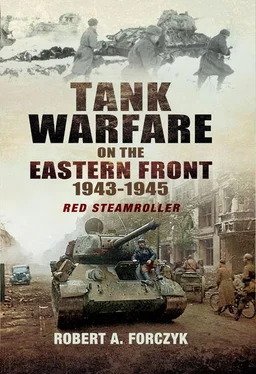Model responded to the 20.Panzer-Division’s success by moving up the 2. and 9.Panzer-Divisionen to assist with reducing the Soviet second line of defence on the next day. The AOK 9 had suffered very heavy personnel casualties on the first day of Zitadelle : 7,223 dead and wounded, particularly in the infantry and pioniers. While Pukhov’s first line of defence had been severely reduced, no breakthrough had been achieved. Pukhov had already committed more than half his armour to contain the German advances, but with limited effect. Rokossovsky watched the partial collapse of Pukhov’s first line of defence with dismay and with Zhukov hovering over him, he decided to commit Rodin’s 2TA and the separate 19th Tank Corps to a major counter-attack on the next day to restore the previous frontline. Rokossovsky’s hasty decision was a major departure from the Soviet battle plan (although Zhukov raised no objections), since the tank armies were supposed to stay out of the battle until the mines and anti-tank defences had reduced the Panzer-Divisionen, but this was not yet the case. Instead, Rokossovsky was playing straight into the German battle plan, provoking a major tank battle while the German heavy armour was still operational.
As dawn arrived on the second day of Zitadelle , the Germans were slow to resume their offensive and 2.Panzer-Division was still in its tactical assembly area. Suddenly, a group of 25 Soviet A-20 bombers came in low and bombed the assembly area, inflicting casualties and damage. Although Luftflotte 6 was winning the battle for air superiority over the northern battlefield, the VVS was still capable of conducting painful low-level raids. Meanwhile, Rokossovsky’s armour was moving northward to engage the German armour near Pukhov’s second line of defence. Rodin’s two corps had to conduct a ‘forward passage of lines’ during the pre-dawn darkness, which is a tedious and problematic affair even for the best trained units. This passage entails tankers coordinating with the front-line infantry commanders to establish one or more lanes through their defensive positions, marking the lanes and posting guides, then moving through as quietly as possible in a long column that makes an excellent target for enemy artillery. At Kursk, particular attention had to be paid to not driving into friendly minefields in the dark. With luck, the combat elements of a large armoured unit like a tank corps might complete a forward passage of lines within a couple of hours, but this was not a strength of the Red Army’s tankers. Instead of three tank corps hitting the Germans at dawn, only part of General-major Vasily E. Grigor’ev’s 16th Tank Corps managed to complete its forward passage of lines by 1000 hours and then advanced northward to the village of Bobrik. In fact, Grigor’ev conducted his movement to contact with just his 107th and 164th Tank Brigades. This mass of about 90 Soviet tanks crawled forward without reconnaissance out in front or infantry or artillery support; it was just a wedge of steel.
Near the village of Bobrik, Major Sauvant’s Tigers had finished a leisurely breakfast and re-supply while sitting in an overwatch position and awaiting orders to resume the attack. Sauvant was one of the most experienced junior Panzer commanders in the Heer, having risen from company commander in Poland in 1939 to battalion commander in 1942 and even being one of the lucky few from the old 14.Panzer-Division to survive Stalingrad. Now Sauvant was provided with the perfect killing machine in an optimal tactical position. Sauvant’s crews spotted the approaching mass of Soviet armour and had plenty of time to ram Panzergranate rounds into their breaches and select targets. Polkovnik Nikolai M. Teliakov, a veteran tanker himself, led the lead 107th Tank Brigade. Sauvant’s Tigers began the engagement at about 1,200 meters with the 8.8cm rounds ripping into the lead Soviet tank company. Although the Soviet tankers could clearly see the Tigers, return fire was completely ineffective at this range. Teliakov had difficulty controlling his brigade, which was being shot to pieces in just a few minutes, but finally managed to extract some survivors and beat a hasty retreat. In less than fifteen minutes, Teliakov’s brigade lost 46 tanks for no loss to Sauvant’s Tigers. Podpolkovnik Nikolai V. Kopylov’s 164th Tank Brigade, trailing Teliakov, witnessed the destruction of his brigade and opted to steer away from the Tigers, but blundered straight into a Kampfgruppe from 2.Panzer-Division. This meeting action was more favourable for the Soviets; Kopylov lost 23 tanks but managed to knock out 10 German tanks before retreating. With Grigor’ev’s 16th Tank Corps bloodied and the rest of his armour still unready to attack, Rodin was able to convince Rokossovsky to cancel the counter-attack and revert to a pure defence.
Model was in no hurry to resume the offensive. He decided to commit the 9.Panzer-Division in Harpe’s sector and he ordered his two flank corps to continue limited objectives attacks. Then, he waited for Luftflotte 6 to gain air superiority over the sector, which they did. Soviet air losses over the northern battlefield on the first two days of Zitadelle were horrendous – 191 aircraft versus 36 for the Luftwaffe. With the skies cleared of enemy bombers, Model began to attack Pukhov’s second line of defence around noon. There was no real Schwerpunkt on this second day of Zitadelle , just short-range jabs by 2.Panzer-Division and Sauvant’s Tigers toward Ol’khovatka and by 9.Panzer-Division toward the Snova River valley. Harpe’s XXXXI Panzerkorps mopped up the remnants of the 81st Rifle Division north of Ponyri, with the support of the remaining Ferdinands and 18.Panzer-Division. Polkovnik Nikolai V. Petrushin’s 129th Tank Brigade (more than 40 tanks) tried to support the hard-pressed Soviet infantry but was driven off by the Ferdinand’s long 8.8cm gun. However, a few SU-152s managed to get into good firing positions and engaged the Ferdinands; at least one Ferdinand was knocked out with a flank shot from 800 metres. Nevertheless, the Germans pressed on and with the added help of Generalleutnant Walter Scheller’s 9.Panzer-Division approaching from the northwest, reached the outskirts of Ponyri by dusk. As the last of his first line of defence crumbled, Pukhov had time to move the 307th Rifle Division and the rest of Petrushin’s 129th Tank Brigade to hold Ponyri. Pukhov placed General-major Mikhail A. Enshin, an NKVD officer, in charge of the defence of Ponyri.
Lemelsen’s XXXXVII Panzerkorps pushed toward Ol’khovatka with Generalleutnant Vollrath Lübbe’s 2. Panzer-Division in the lead. Lübbe’s Panzers found the Soviet second line in this sector held by the 6th Guards Rifle Division (6 GRD), which was well supported by artillery and anti-tank guns. The German tanks blundered into a minefield and no less than 12 of Sauvant’s Tigers suffered mine damage. Heavy artillery fire pounded the Germans while they were tangled out in the obstacle belt and high velocity 76.2mm rounds ripped into immobilized vehicles. Lübbe’s Panzers managed to push through some weak spots in the 6 GRD’s line, but then ran straight into elements of the 70th and 75th Guards Rifle Divisions. Soviet POZ detachments laid new mines in front of the approaching Panzers, just as they thought they had cleared the obstacle belt. As evening approached, General-major Ivan D. Vasil’ev’s 19th Tank Corps mounted a sudden counter-attack into Lemelsen’s right flank, but the 20.Panzer-Division was screening this area and knocked out 30 T-34s. The day was a disappointment for Model, with more heavy casualties and no breakthrough achieved. At best, his Panzers had advanced another 2–4km, but it was clear that Soviet resistance was getting tougher. Although not hopeful of achieving a real breakthrough and linking up with von Manstein’s forces, Model decided to commit his remaining armour, the 4. and 12.Panzer-Divisionen on the next day.
Читать дальше








![John Stieber - Against the Odds - Survival on the Russian Front 1944-1945 [2nd Edition]](/books/405234/john-stieber-against-the-odds-survival-on-the-russian-front-1944-1945-2nd-edition-thumb.webp)



